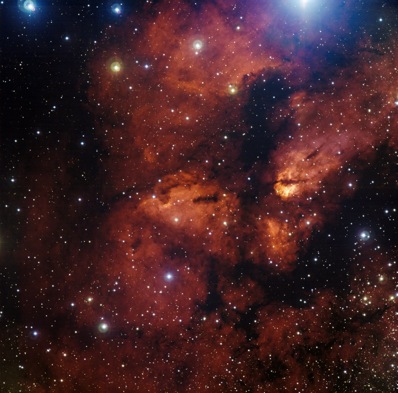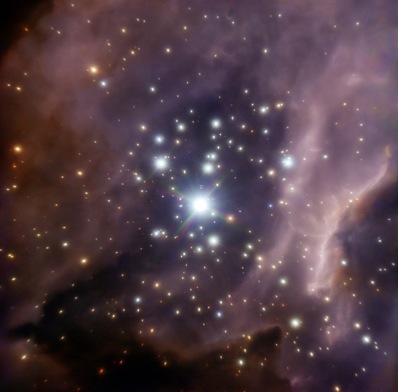
ESO peers deep into the hellish birthplaces of stars
DR EMILY BALDWIN
ASTRONOMY NOW
Posted: August 19, 2009


New images released today by ESO delve deep into the star-forming furnace of RCW 38, a dense cluster located 5,500 light years away towards the constellation Vela.
Like the Orion Nebula Cluster, RCW 38 is enveloped in a nascent cloud of dust and gas from which new stars are born. These young stars bombard their companions – other stars and planetary systems – with blistering radiation and powerful winds, an environment in which astronomers believe our own Solar System may have emerged.
 RCW 38 might represent a similar environment in which our own Solar System formed. Image: ESO.
RCW 38 might represent a similar environment in which our own Solar System formed. Image: ESO.
"By looking at star clusters like RCW 38, we can learn a great deal about the origins of our Solar System and others, as well as those stars and planets that have yet to come," says Kim DeRose, lead author of the new study. Astronomers have determined that most stars, including the low mass red stars that outnumber all others in the Universe, originate in these matter-rich locations, making them ideal natural laboratories in which to study the different stages of star and planet formation.
The team used the NACO adaptive optics instruments on ESO's Very Large Telescope to obtain the sharpest images of RCW 38 yet. Focusing on the heart of the cluster where hot, massive star IRS2 resides, the team made the dramatic discovery that this giant star is in fact a binary system separated by 500 times the Earth-Sun distance.
 Studying the central part of RCW 38 revealed IRS2 as two almost equally massive stars. Image: ESO.
Studying the central part of RCW 38 revealed IRS2 as two almost equally massive stars. Image: ESO.
The new images also revealed a handful of protostars that are holding on to life despite being bathed in intense ultraviolet radiation blasted out by IRS2. These stellar babies may not evolve into fully-fledge stars, however, for the radiation here is energising and dispersing the material that might otherwise collapse into new stars. Surviving discs may eventually, over the course of several million years, spawn planetary systems like our own.
If the intense radiation from new born stars wasn't enough, the crowded stellar nursery also has to contend with frequent supernova blasts as the elderly population of stars scream out their deaths. Material scattered through the local neighbourhood in these blasts eventually gets swept up as ingredients to build the next generation of stars.
Exotic forms of chemical elements and rare isotopes are created in these dying stars, some of which have been detected in our own Sun, suggesting that it formed in a chaotic star cluster like RCW 38 rather than a calmer part of the Milky Way.
|



